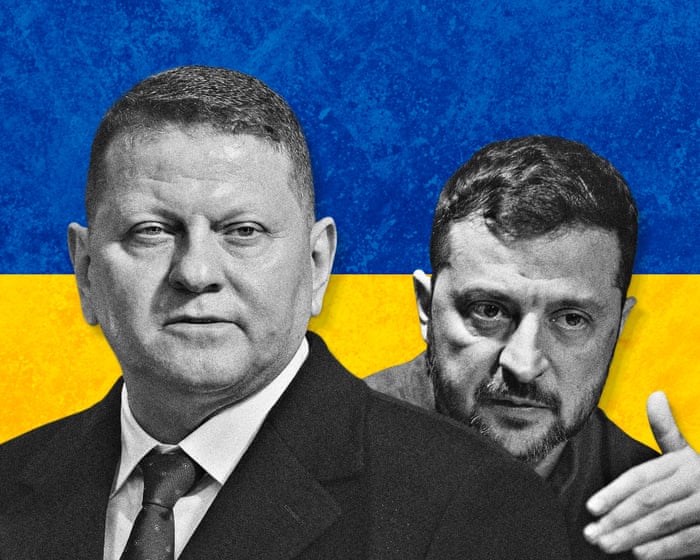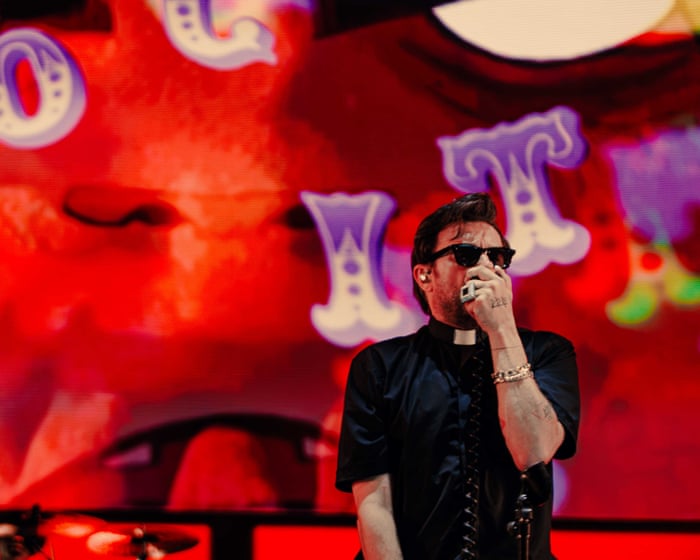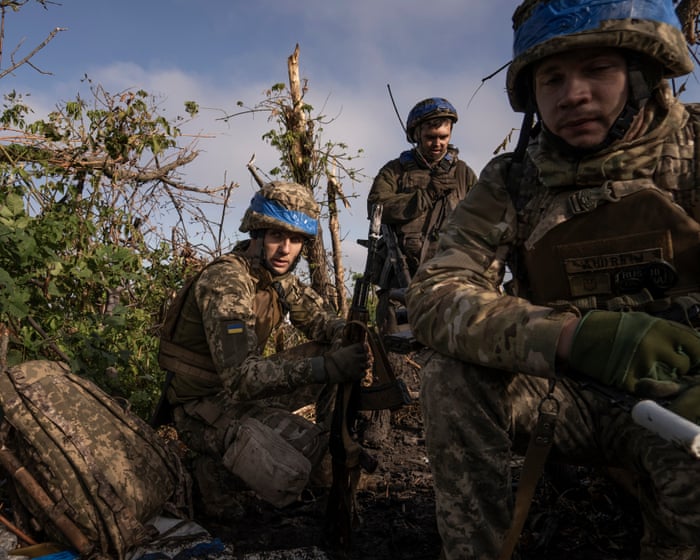This CSS code defines a custom font family called “Guardian Headline Full” with multiple font weights and styles. It includes light, regular, medium, and semibold weights, each with normal and italic variants. The font files are provided in WOFF2, WOFF, and TrueType formats, sourced from the Guardian’s asset server.@font-face {
font-family: ‘Guardian Headline Full’;
src: url(‘https://assets.guim.co.uk/static/frontend/fonts/guardian-headline/noalts-not-hinted/GHGuardianHeadline-Bold.woff2’) format(‘woff2’),
url(‘https://assets.guim.co.uk/static/frontend/fonts/guardian-headline/noalts-not-hinted/GHGuardianHeadline-Bold.woff’) format(‘woff’),
url(‘https://assets.guim.co.uk/static/frontend/fonts/guardian-headline/noalts-not-hinted/GHGuardianHeadline-Bold.ttf’) format(‘truetype’);
font-weight: 700;
font-style: normal;
}
@font-face {
font-family: ‘Guardian Headline Full’;
src: url(‘https://assets.guim.co.uk/static/frontend/fonts/guardian-headline/noalts-not-hinted/GHGuardianHeadline-BoldItalic.woff2’) format(‘woff2’),
url(‘https://assets.guim.co.uk/static/frontend/fonts/guardian-headline/noalts-not-hinted/GHGuardianHeadline-BoldItalic.woff’) format(‘woff’),
url(‘https://assets.guim.co.uk/static/frontend/fonts/guardian-headline/noalts-not-hinted/GHGuardianHeadline-BoldItalic.ttf’) format(‘truetype’);
font-weight: 700;
font-style: italic;
}
@font-face {
font-family: ‘Guardian Headline Full’;
src: url(‘https://assets.guim.co.uk/static/frontend/fonts/guardian-headline/noalts-not-hinted/GHGuardianHeadline-Black.woff2’) format(‘woff2’),
url(‘https://assets.guim.co.uk/static/frontend/fonts/guardian-headline/noalts-not-hinted/GHGuardianHeadline-Black.woff’) format(‘woff’),
url(‘https://assets.guim.co.uk/static/frontend/fonts/guardian-headline/noalts-not-hinted/GHGuardianHeadline-Black.ttf’) format(‘truetype’);
font-weight: 900;
font-style: normal;
}
@font-face {
font-family: ‘Guardian Headline Full’;
src: url(‘https://assets.guim.co.uk/static/frontend/fonts/guardian-headline/noalts-not-hinted/GHGuardianHeadline-BlackItalic.woff2’) format(‘woff2’),
url(‘https://assets.guim.co.uk/static/frontend/fonts/guardian-headline/noalts-not-hinted/GHGuardianHeadline-BlackItalic.woff’) format(‘woff’),
url(‘https://assets.guim.co.uk/static/frontend/fonts/guardian-headline/noalts-not-hinted/GHGuardianHeadline-BlackItalic.ttf’) format(‘truetype’);
font-weight: 900;
font-style: italic;
}
@font-face {
font-family: ‘Guardian Titlepiece’;
src: url(‘https://assets.guim.co.uk/static/frontend/fonts/guardian-titlepiece/noalts-not-hinted/GTGuardianTitlepiece-Bold.woff2’) format(‘woff2’),
url(‘https://assets.guim.co.uk/static/frontend/fonts/guardian-titlepiece/noalts-not-hinted/GTGuardianTitlepiece-Bold.woff’) format(‘woff’),
url(‘https://assets.guim.co.uk/static/frontend/fonts/guardian-titlepiece/noalts-not-hinted/GTGuardianTitlepiece-Bold.ttf’) format(‘truetype’);
font-weight: 700;
font-style: normal;
}
@media (min-width: 71.25em) {
.content__main-column–interactive {
margin-left: 160px;
}
}
@media (min-width: 81.25em) {
.content__main-column–interactive {
margin-left: 240px;
}
}
.content__main-column–interactive .element-atom {
max-width: 620px;
}
@media (max-width: 46.24em) {
.content__main-column–interactive .element-atom {
max-width: 100%;
}
}
.content__main-column–interactive .element-showcase {
margin-left: 0;
}
@media (min-width: 46.25em) {
.content__main-column–interactive .element-showcase {
max-width: 620px;
}
}
@media (min-width: 71.25em) {
.content__main-column–interactive .element-showcase {
max-width: 860px;
}
}
.content__main-column–interactive .element-immersive {
max-width: 1100px;
}
@media (max-width: 46.24em) {
.content__main-column–interactive .element-immersive {
width: calc(100vw – var(–scrollbar-width));
position: relative;
left: 50%;
right: 50%;
margin-left: calc(-50vw + var(–half-scrollbar-width)) !important;
margin-right: calc(-50vw + var(–half-scrollbar-width)) !important;
}
}
@media (min-width: 46.25em) {
.content__main-column–interactive .element-immersive {
transform: translate(-20px);
width: calc(100% + 60px);
}
}
@media (max-width: 71.24em) {
.content__main-column–interactive .element-immersive {
margin-left: 0;
margin-right: 0;
}
}
@media (min-width: 71.25em) {
.content__main-column–interactive .element-immersive {
transform: translate(0);
width: auto;
}
}
@media (min-width: 81.25em) {
.content__main-column–interactive .element-immersive {
max-width: 1260px;
}
}
.content__main-column–interactive p,
.content__main-column–interactive ul {
max-width: 620px;
}
.content__main-column–interactive:before {
position: absolute;
top: 0;
height: calc(100% + 15px);
min-height: 100px;
content: “”;
}
@media (min-width: 71.25em) {
.content__main-column–interactive:before {
left: 0;
width: 1px;
background: #dcdcdc;
}
}This appears to be a block of CSS code, likely from a website’s stylesheet. It defines various styles for elements such as columns, interactive content, and typography, including colors, spacing, and layout rules. The code includes media queries for responsive design and uses CSS custom properties (variables) for consistent theming.The provided CSS code adjusts the layout and styling for various elements on a webpage. It removes top padding for paragraphs following horizontal rules in specific containers, positions captions for showcase elements statically with a maximum width, and handles immersive elements by setting their width relative to the viewport.
For immersive elements, it adjusts maximum widths and caption padding at different screen sizes. On smaller screens, it modifies margins to align content properly.
A furniture wrapper uses a grid layout on larger screens, defining columns and rows for placement. It styles headlines, metadata, and standfirst text—including borders, spacing, font sizes, and link decorations—with hover effects changing underline colors. Figures within this wrapper are adjusted for margin and maximum width.
Media queries ensure these styles apply responsively across various device widths.The provided text appears to be CSS code for styling a webpage layout. It defines grid structures, media queries for responsiveness, and visual properties like colors, borders, and spacing. The code includes selectors for elements such as headlines, meta information, and media containers, with adjustments for different screen sizes.The second span in a figure caption within the furniture-wrapper is set to display as a block with a maximum width of 90%. On screens wider than 30em, the caption padding is adjusted to 4px at the top, 20px on the sides, and 12px at the bottom. Captions with the “hidden” class are made invisible.
A caption button is displayed as a block, positioned absolutely near the bottom right, with a circular background and no border. Its SVG icon is scaled down slightly. On wider screens (30em and above), the button is positioned 10px from the right edge.
For interactive main columns on very large screens (71.25em and above), a pseudo-element is adjusted to extend slightly above and below the content.
Headings in the interactive main column are limited to a maximum width of 620px.
On iOS and Android devices, dark mode colors are defined: a dark background, a red feature color, and a slightly different red for dark mode. The new pillar color uses the primary or dark mode variant as appropriate.
In dark mode on these devices, the new pillar color switches to the dark mode variant.
For the first letter of the first paragraph after certain elements in iOS and Android article containers, the color is set to a secondary pillar color (defaulting to black if not defined).
Article headers on these platforms have no height, effectively hiding them.
The furniture-wrapper in article containers has reduced padding: 4px top, 10px sides, and 0 bottom.
Labels within the furniture-wrapper use a bold font weight and the “Gu” font family.The Guardian headline font is set to Guardian Headline, Guardian Egyptian Web, Guardian Headline Full, Georgia, serif. It uses a specific color and capitalizes text.
On iOS and Android devices, article headlines are styled with a 32px font size, bold weight, 12px bottom padding, and a dark gray color.
Images within articles are positioned relatively, with a left margin of -10px and a top margin of 14px. Their width adjusts to the viewport minus the scrollbar, and their height is set to auto.
The standfirst section, which provides a summary or introduction, has top and bottom padding of 4px and 24px respectively, and a right margin of -10px. The text inside uses the same font family as the headline.
Links and list items within the standfirst also follow these styling rules.For iOS and Android devices, links within the standfirst section of feature, standard, and comment articles are styled with a specific color, an underline, and no background image. The underline color changes on hover. Additionally, the meta section in these articles has no margin, and byline elements are styled consistently.For iOS and Android devices, the author’s name in article bylines is styled using a specific color variable. The miscellaneous metadata section in article containers has no padding, and any SVG icons within it use a designated color for their strokes.
The caption button in showcase elements is displayed as a flex container, centered with specific dimensions and positioning. The main body of articles has horizontal padding, and standard image elements (excluding thumbnails and immersive types) are set to full width with automatic height and no margin. Their captions have no padding. Immersive image elements follow similar styling rules.For Android devices, immersive images in article containers are set to the full viewport width minus the scrollbar width.
On both iOS and Android, quoted text in article bodies uses the new pillar color for its decorative element. Links in the article body are styled with the primary pillar color, an underline offset by 6 pixels, and a specific underline color. On hover, the underline color changes to the new pillar color.
In dark mode, the furniture wrapper background becomes dark gray. Labels within it use the new pillar color, headlines adopt a specific border color, and standfirst text and links also use that border color.For iOS and Android devices, the author byline links in feature, standard, and comment articles use the new pillar color. Icons in the meta section of these articles also use the new pillar color for their stroke. Showcase image captions in these articles use the dateline color. Blockquotes within the article body are styled with the new pillar color. The main content areas of feature, standard, and comment articles, including article body, interactive content, feature body, and comment body, are styled consistently.For Android devices, set the background color of specific comment and article containers to a dark background.
For iOS devices, apply a special style to the first letter of paragraphs that follow certain elements within article, feature, and comment containers.This CSS code targets the first letter of paragraphs that follow specific elements, such as those with the class “element-atom” or elements with the ID “sign-in-gate,” across various article and comment containers on both iOS and Android platforms.On an early March afternoon, just three days after the tense meeting between Donald Trump and Volodymyr Zelenskyy at the White House, the Ukrainian embassy in London was busy with phone calls. JD Vance’s team reached out, hoping to arrange a conversation with Valerii Zaluzhnyi, Ukraine’s ambassador to the UK and former army commander-in-chief.
Vance, who had played a role in the Oval Office confrontation from his seat nearby, was now exploring potential alternatives to Zelenskyy. According to one of three sources familiar with the situation, Vance’s team used “various diplomatic and other channels” to contact Zaluzhnyi. After consulting with Zelenskyy’s chief of staff, Zaluzhnyi declined the call.
This incident highlights the delicate political position Zaluzhnyi has been in since Zelenskyy removed him as army chief.In February, my boss was sent to London as ambassador. Zaluzhnyi, accustomed to a strict military chain of command, remains loyal to the government he serves. Yet many—both in Ukraine and abroad—view him as the country’s natural next president and are urging him to enter politics.
This account is based on interviews with people close to Zaluzhnyi, as well as political insiders, diplomats, and others with direct knowledge of the events. Most requested anonymity due to the sensitivity of the topic. Many details are being reported here for the first time.
No election is currently scheduled in Ukraine, as voting is legally and practically impossible during wartime. Even Zelenskyy’s strongest domestic opponents oppose holding a vote now. Relations with Trump have also improved since the tense Oval Office meeting, and last week the Ukrainian president returned to the White House in a more cordial atmosphere.
Still, everyone in Ukraine knows that politics will eventually resume. When it does, polls suggest Zaluzhnyi—who led the successful defense against Russia’s initial invasion—is the only candidate who could seriously challenge Zelenskyy.
Zaluzhnyi has never publicly expressed political ambitions and rarely grants interviews. His team carefully manages his public appearances in London to avoid events where difficult questions might arise. Yet a steady stream of political visitors has been making its way to the Ukrainian embassy, a mansion near Holland Park, to offer support, services, or to gauge whether the general plans to run for office.
These visitors have included Ukrainian MPs, civil society activists, representatives of wealthy business figures, and even Paul Manafort, the disgraced former Trump adviser, who pitched his services as a political consultant for a future campaign. Zaluzhnyi declined the offer.
Another frequent visitor has been Andriy Yermak, Zelenskyy’s influential chief of staff. In a meeting last November, Yermak reportedly suggested that Zaluzhnyi formally join the president’s political team to present a united front ahead of future elections.
Zaluzhnyi declined but pledged a degree of loyalty. He promised not to criticize Zelenskyy publicly while the war continues and assured the presidential office he would not spring any surprises. “If I decide to go into politics, you’ll hear it from me first, in private,” Zaluzhnyi told Yermak.
So far, that message hasn’t been delivered, though there is growing belief in Kyiv that Zaluzhnyi is preparing a political run. The general remains evasive even with close associates about his plans, but many assume he is simply waiting for the right moment.
“He has chosen the smartest tactic,” said Volodymyr Fesenko, a political analyst in Kyiv. “He will make his final decision only at the last minute, just before elections.”
Zaluzhnyi was 48 when Zelenskyy appointed him commander-in-chief in July 2021—a surprise to much of the military leadership, including Zaluzhnyi himself.
“Zaluzhnyi was a bold and ambitious commander, but also something of a goofball, better known for joking with his troops than disciplining them,” wrote journalist Simon Shuster in his biography of Zelenskyy. It was this personable, unconventional quality that appealed to Zelenskyy, the former comedian and actor who had unexpectedly risen to the presidency two years earlier.A few months after Valerii Zaluzhnyi was appointed, Russia began building up troops along the border. The Biden administration publicly warned that Vladimir Putin might be planning a full-scale invasion of Ukraine. Between the first U.S. warnings in October 2021 and the actual invasion in February 2022, Zaluzhnyi repeatedly urged more intensive preparations for a possible Russian attack. However, President Volodymyr Zelenskyy was skeptical that the invasion threat was real and worried that over-preparing could cause public panic or give Russia a pretext to invade.
At a meeting of Ukraine’s security council on February 22, Zaluzhnyi and then-Defense Minister Oleksiy Reznikov argued for declaring martial law, while Zelenskyy remained concerned about inciting fear. The council ultimately voted for milder measures. Russia invaded two days later. These behind-the-scenes disagreements over war preparations, which were largely overshadowed by Zelenskyy’s heroic leadership after the invasion, could resurface if the two men face off in an election.
Once the war began, Zelenskyy initially left military strategy to Zaluzhnyi while focusing on rallying international support for Kyiv. Zelenskyy became the global face of Ukrainian resistance, while Zaluzhnyi gained near-mythical status at home as a war hero.
As the conflict continued, tensions grew between them. Strategy meetings often ended in disagreement, and Zelenskyy’s team grew uneasy about Zaluzhnyi’s soaring popularity, as indicated by internal polling. He was becoming an untouchable figure.
By February of last year, Zelenskyy had had enough. After months of speculation, he dismissed Zaluzhnyi as army chief and announced his appointment as ambassador to London, stating the military needed “new ideas.” Zelenskyy insisted the decision wasn’t personal or political, though few believed that. Zaluzhnyi accepted the change calmly. In a private meeting, the two parted on good terms and even posed together for a photo to show there was no ill will. It was their last in-person meeting.
When Zaluzhnyi arrived in London, British officials recognized the need for careful handling. Many had built close ties with Zaluzhnyi during the war but understood that involving him in military discussions could strain relations with Zelenskyy’s administration and show disrespect to his successor, Oleksandr Syrskyi.
A British defense official said, “Despite many warm personal connections, it was decided to reset the relationship to a more traditional diplomatic one, led by the Foreign Office.”
For Zaluzhnyi, who had spent two years in a state of constant alert and sleep deprivation, life in London was a strange adjustment. He posted selfies with his wife from tube stations and walks along the Thames. The couple even went to the theater occasionally, including a pre-Christmas show of “Barcelona,” starring Lily Collins. The unusually thorough security sweep before the performance led staff to assume a royal family member was attending.According to a source at the theatre, there was confusion when the secret VIP couple arrived and no one recognized them.
Back home, where Zaluzhnyi has the second-most recognizable face in Ukraine, photos from his new life haven’t always been well received. A moody black-and-white photoshoot for Ukrainian Vogue recently sparked a wave of sarcastic memes. Still, Zaluzhnyi has kept in touch with many army commanders and monitors combat activities through secure video screens in his office that show live footage from the battlefield. “Valerii Fedorovych has left the war, but the war has not left Valerii Fedorovych,” said an associate, using Zaluzhnyi’s full name.
In private talks, Zaluzhnyi hasn’t confirmed plans to enter politics, but he has considered what kind of platform he might propose if he does. Those close to him say he sees Israel as a model—despite its current actions in Gaza—viewing it as a small nation surrounded by enemies and entirely focused on defense.
He would position himself as a tough, wartime leader, promising “blood, sweat, and tears” to the Ukrainian people in exchange for saving the nation, echoing Winston Churchill. In one private conversation, he remarked, “I don’t know if the Ukrainian people will be ready for that, ready for such tough policies.”
After Trump humiliated Zelenskyy in the Oval Office in February, the Ukrainian president flew to London to strategize with Keir Starmer on how to repair the relationship. The situation looked grim, and some in the U.S. administration openly discussed ways to replace Zelenskyy. “I don’t know if we can ever work with Zelenskyy again,” said Republican senator Lindsey Graham, publicly suggesting Zelenskyy should resign. Soon after, Vance’s office tried to reach out to Zaluzhnyi.
For Zaluzhnyi, despite any tensions with Zelenskyy, siding with Trump’s team against his own president was not an option. He met Zelenskyy at the airport in London and posted a photo of them shaking hands on social media. “The road ahead won’t be easy, but together, we will overcome every challenge,” he wrote. It was a clear show of unity at one of Ukraine’s lowest points since the full-scale invasion began.
“Many of his supporters didn’t understand why he did this,” said a source close to Zaluzhnyi. “But it was his principled stance: Ukraine has been humiliated, and we must stand united.”
This caution has started to frustrate some of Zelenskyy’s opponents in Kyiv, who see Zaluzhnyi as their best hope for political change. “He’s a military man—he understands taking orders and working within a structure, but he doesn’t grasp political maneuvering,” said a former senior official hoping to persuade Zaluzhnyi to run. “A real leader should have taken Vance’s call and made moves. But how do you convince him?”
Another source, who knows Zaluzhnyi and is also a former senior official, said the general would be too cautious about causing internal instability to launch a political campaign against Zelenskyy. “I don’t believe in a battle between the two Zs—it would be a disaster for the country, and I don’t think he’s ready for that. So I believe he would only run if Zelenskyy can be persuaded to step aside,” the source said.
Last month, Zaluzhnyi arrived in Kyiv for a six-day summit of Ukrainian ambassadors. The envoys heard speeches from Zelenskyy and military leaders and visited areas near the frontline in the Zaporizhzhia region. For most diplomats, it was a rare firsthand experience of the war to take back to their host countries. For Zaluzhnyi, it was another chapter in his ongoing connection to the conflict.Returning to the front as part of a diplomatic mission must have been a surreal experience.
“He was friendly but cautious,” another ambassador who was present remarked. “You could tell he was careful not to be too open with people he didn’t know personally—he wasn’t sure whose side anyone was on.”
By coincidence, the summit brought Zaluzhnyi to Kyiv just as street protests erupted against a government plan to weaken two anti-corruption agencies. The demonstrations alarmed Zelenskyy’s team and prompted a quick reversal. Some hoped this might be the moment Zaluzhnyi would publicly break with Zelenskyy. “Many were waiting for him to speak out, but he stayed silent,” said Inna Sovsun, an opposition MP.
After the summit, Zaluzhnyi remained in Kyiv for a week, holding numerous meetings with various political and civic figures. Rumors spread that he was finally exploring the possibility of forming a future political team.
Those close to him deny the discussions were political. “He has repeatedly said that while the war continues, our focus must be on saving the country, not elections—and that hasn’t changed,” said Oksana Torop, a former BBC journalist now serving as Zaluzhnyi’s media adviser. “He speaks with many people about defense and security, but it has nothing to do with elections,” she added.
When asked if the presidential office views Zaluzhnyi as a political threat, Zelenskyy aide Mykhailo Podolyak responded, “The president sees Zaluzhnyi as part of the team, like an ambassador to an important country… Besides, there’s no real political process happening right now.”
What about when political processes eventually resume, whenever that may be? “I can’t predict what would happen then or how different people might act,” said Podolyak. “It’s all very unpredictable.”
Frequently Asked Questions
Of course Here is a list of FAQs about General Valerii Zaluzhnyis diplomatic role in London and his potential political future
General Background
Q Who is Valerii Zaluzhnyi
A He is the former CommanderinChief of the Armed Forces of Ukraine He is widely credited with leading Ukraines defense against the 2022 fullscale Russian invasion and is a highly respected national figure
Q What is his current role
A In March 2024 he was appointed by President Zelenskyy as Ukraines Ambassador to the United Kingdom This is a diplomatic post not a military one
Q Why was a general made an ambassador
A Its a strategic move His immense credibility and stature ensure he has direct access to the highest levels of the UK government making him a very powerful advocate for Ukraines military and financial needs
The Waiting Game Political Future
Q What is the waiting game mentioned in the context of London
A It refers to the widespread speculation that his ambassadorship is a temporary highprofile posting Many believe he is waiting in this role before eventually returning to Ukraine to pursue a political career potentially including a run for president
Q Is he planning to run for president of Ukraine
A He has not officially announced any candidacy However he consistently ranks as the most popular potential candidate in opinion polls making a future presidential bid a strong possibility that many are watching
Q Can an ambassador run for president
A Yes but he would have to resign from his diplomatic post to officially launch a campaign There are no legal barriers preventing him from doing so
Q When could a presidential election happen
A Ukraines constitution requires elections every five years The next one was scheduled for March 2024 but was postponed due to the ongoing war under martial law An election will likely be held after the war ends or martial law is lifted
Deeper Analysis Implications
Q What are the benefits of having Zaluzhnyi as ambassador




